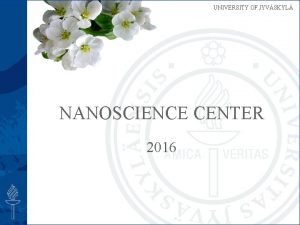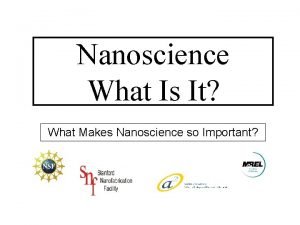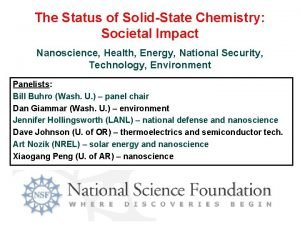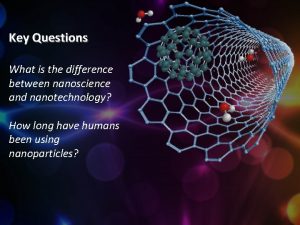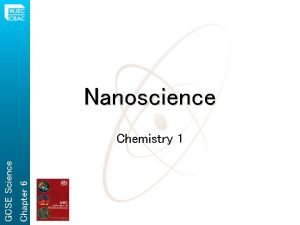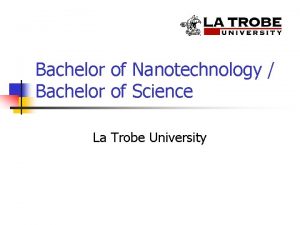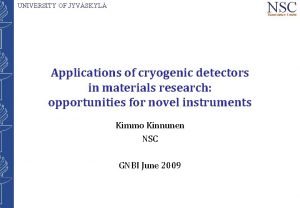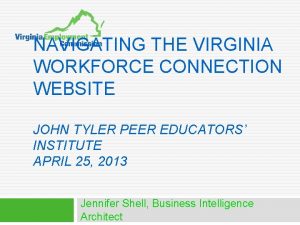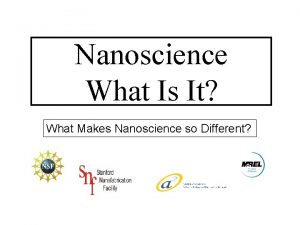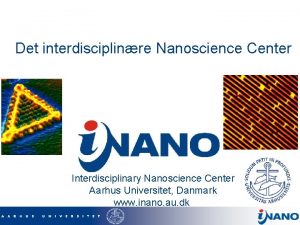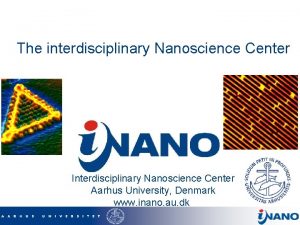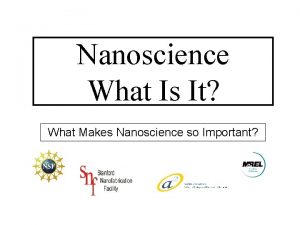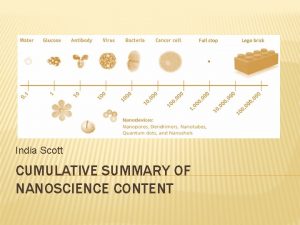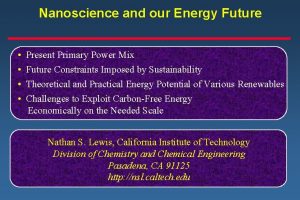DEVELOPING THE NANOSCIENCE WORKFORCE OF THE FUTURE LINKING




































- Slides: 36

DEVELOPING THE NANOSCIENCE WORKFORCE OF THE FUTURE: LINKING NANOTECHNOLOGY AND RESEARCH TO THE ENVIRONMENT

DISCOVERY KNOWLEDGE TECHNOLOGY SOCIETY DISCOVERY? ? A cycle driven by curiosity and exploration, tempered by need and prejudice

NANOSCALE CONCEPTS What is Nanotechnology? Nanotechnology is defined as the application of science to developing new materials and processes by manipulating molecular and atomic http: //www. nint. ca/nav 01. cfm? nav 01=12988 particles.


Nanotechnology Will Change Our World

MULTI-DISCIPLINARY AND CREATIVIT http: //www. ccst. us/ccst/pubs/nano/lib/Project. Description. pdf Merrill-Lynch review

http: //nint-innt. nrc-cnrc. gc. ca/home/index_e. html

Two approaches to manufacture of nanomaterials Bottom-Up Chemical Synthesis Selfassembly Top-down Positional assembly Lithography (RS&RAD, 2004) Cutting, Etching, Grinding Electronic devices Crystals, Particle and chip masks molecules Films, Tubes Experimental atomic or molecular devices Precision engineered surfaces Cosmetics, Fuel additives High quality optical mirrors Displays Quantum well lasers, computer chips, Micro-electro-mechanical systems (MEMS) Independent approaches have converged in terms of feature size and quality achieved

http: //nint-innt. nrc-cnrc. gc. ca/research/supra_e. html

http: //nint-innt. nrc-cnrc. gc. ca/research/supra_e. html

Inspection and Manipulation of Single Molecules NEW MICROSCOPY OPENS THE WAY TO NANOTECHNOLOGY This is the size scale of interest to nanoscience and nanotechnology; ~0. 000000010 meters in length or less or about 1/10, 000 width of a human hair

Founders – Atomic Force Method Heinrich Rohrer Gerd Binning

Atomic Force Microscopy AFM invented in 1986 by g. Binning. STM in 1982 by H. Roher and G. Binning

Lateral Force Mode involves only x-y movement In contact mode x-y and z movement is involved

Modifying a “wire” Ros et al. , PSI Annual Report, 1999.

Binding force measurements Ros et al. , PSI Annual Report, 1999.

Nano wire manipulation on polymer film: The images are taken in intermittent contact mode while the wire has been moved successively with contact mode by applying a constant force of 2. 2 n. N. Scan field 400 nm X 550 nm, z-range 0 - 5 nm (http: //www. jpk. com/spm/gallery 1. htm#litho)

WIRING: CARBON NANOTUBE (another form of carbon compound) http: //www. personal. rdg. ac. uk/~scsharip/tubes. htm

Columbia – Chem. Eng.




Li and Tan, Nano Letters, 2 (2002) 315.

Li and Tan, Nano Letters, 2 (2002) 315.

INSTITUTE OF PHYSICS PUBLISHING NANOTECHNOLOGY Nanotechnology 13 (2002) R 15–R 28 PII: S 09574484(02)52701 -X TUTORIAL Natural strategies for the molecular engineer Philip Ball Nature, 4 -6 Crinan St, London N 1 9 XW, UK E-mail: p. ball@nature. com Received 23 August 2002 Published 11 September 2002 Online at stacks. iop. org/Nano/13/R 15



Tools to measure position – THE “MOLECULAR RULER” Cardullo, Microscopy and Analysis, Issue 53 (2002)

Inorganic Semiconductor Quantum Dots (QD) http: //probes. invitrogen. com/products/qdot/overview. html Wavelength tuning based on size ® Excitable in UV region ® FRET applications ® Multicolour detection ® • Core/shell structure • Functionalize surface with species capable of covalently binding DNA, dye

Quantum Dot Surface Functionalization Cd. Se/Zn. S MAA, chloroform, Hunig’s base EDC, amine terminated dye/DNA

QD-FRET-based strategy for two-colour nucleic acid detection. a) Simultaneous and efficient excitation of green and red quantum dots in the ultraviolet-region without significant excitation of Cy 3 or Alexa 647 in solution. When probe oligonucleotides were conjugated to QDs, hybridization with a Cy 3 or Alexa 647 labeled target oligonucleotide yielded FRET sensitized emission from the dyes, which was used as the analytical signal. The green QD-Cy 3 FRET pair utilized the SMN 1 sequence and the red QD-Alexa 647 pair utilized the Lac. Z sequence. b) A cartoon of the expected emission profiles, where the bracketed regions are of particular analytical interest.

Top Ten Nanotechnologies Contributing to Developing World How much difference will the technology make in improving water, agriculture, nutrition, health, energy, and the environment in developing countries? Burden. Will it address the most pressing needs? Appropriateness. Will it be affordable, robust, and adjustable to settings in developing countries, and will it be socially, culturally, and politically acceptable? Feasibility. Can it realistically be developed and deployed in a time frame of ten years? Knowledge gap. Does the technology advance quality of life by creating new knowledge? Indirect benefits. Does it address issues such as capacity building and income generation that have indirect, positive effects on developing countries?


Salamanca-Buentello F, Persad DL, Court EB, Martin DK, Daar AS, et al. (2005) Nanotechnology and the Developing World. PLo. S Med 2(5): e 97


 Dynamic linking vs static linking
Dynamic linking vs static linking Nanoscience
Nanoscience Nanoscience
Nanoscience Nanoscience
Nanoscience Difference between nanoscience and nanotechnology
Difference between nanoscience and nanotechnology Journal of nanoscience and nanotechnology sci
Journal of nanoscience and nanotechnology sci Nanoscience gcse
Nanoscience gcse Disadvantage of nanotechnology
Disadvantage of nanotechnology Nanoscience
Nanoscience Future perfect continuous worksheet
Future perfect continuous worksheet Future perfect continuous and simple
Future perfect continuous and simple Developing employees for future success
Developing employees for future success The perfect future tense
The perfect future tense Plan present progressive
Plan present progressive Nulti i prvi kondicional
Nulti i prvi kondicional Present past future
Present past future Perfect infinitive
Perfect infinitive Future nurse future midwife
Future nurse future midwife See future continuous
See future continuous Future plans and finished future actions
Future plans and finished future actions Parallel action in the future
Parallel action in the future Future perfect and future continuous
Future perfect and future continuous Workforce innovation fund
Workforce innovation fund Vec workforce connection
Vec workforce connection Apsolve
Apsolve Avaya workforce optimization
Avaya workforce optimization Lancashire county council planning
Lancashire county council planning Wfm impact 360
Wfm impact 360 People capability maturity model
People capability maturity model Workforce analysis report
Workforce analysis report Contingent worker intel
Contingent worker intel Education workforce council
Education workforce council Education workforce council
Education workforce council Mynfon
Mynfon Workforce flow
Workforce flow Hrsa workforce connector
Hrsa workforce connector Workforce scheduling model
Workforce scheduling model

